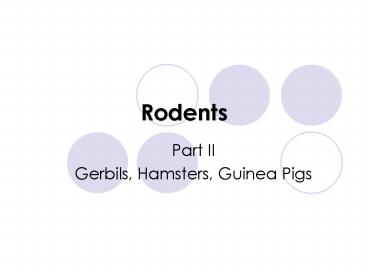Rodents - PowerPoint PPT Presentation
1 / 45
Title:
Rodents
Description:
More than 4000 Species. Largest Order in Class Mammalia ... Burrow live in. complex tunnel. systems. Social. Nutritional Considerations. They are desert animals ... – PowerPoint PPT presentation
Number of Views:186
Avg rating:3.0/5.0
Title: Rodents
1
Rodents
- Part II
- Gerbils, Hamsters, Guinea Pigs
2
Taxonomy
- Class Mammalia
- Order Rodentia
- 3 Suborders
- 30 Families
- More than 4000 Species
- Largest Order in Class Mammalia
3
Order Rodentia
- From Latin Rodere to gnaw
- Large Front Incisors
- Diastema
- (Remember? In Rabbits too)
4
Incisor Comparison
5
Mastication
Side Views of the cranial skull note sharp
incisors and large diastema, similar to rabbits
Lower jaw note large diastema, but more forward
thrusting lower incisors and larger, sharper
molars than rabbits, adapted to grinding forage
materials.
http//www.medaille.edu/vmacer/120_lec_12rabbits.h
tm
6
Rodents in the U.S.
- 15.9 Million Small Animals Owned
(Rodents/Lagomorphs) - In 5.3 Million homes
7
Rodents in the U.S.
- Research
- 244,000 rabbits
- 245,000 guinea pigs
- 180,000 hamsters
- Others 323,000
8
Subfamily Murinae
- Mice
9
History of Mice
- Kept as pets in China and Japan
- Royal Palaces
- 1950s in the US
- Used in Laboratories for scientific study
- Mendelian Genetics
10
Mice as Pets
- Fancy Mice
- Social
- Intelligent
- Explorers
11
Mouse Nutrition
- Omnivores
12
Mouse Nutrition
- Critter Cubes
- Crude Protein
- 21
- Crude Fat
- 4.5
13
Mouse Nutrition
- Seed Diets
- Crude Protein
- 14
- Crude Fat
- 8
14
Mouse Nutrition
- Zupreem?
- Crude Protein
- 14
- Crude fat
- 5
15
Digestive Tract
16
Coprophagic
- Fecal pellets
- High in Protein and B vitamins
- Remember the difference between Coprophagy and
Cecotrophy
17
Life Cycle Awareness
- Mature at 60 days old
- 21 Day Gestation
- 4-8 pups per litter
18
Aging and Lifespan
- Average of 1.5-3 years
- Extend their lifespan by spaying/neutering
19
Subfamily Gerbillinae
- Gerbils
20
History of Gerbils
- Originate in Mongolia
- China to France to U.S.
- 1954 brought to U.S. for Research
- Became a popular pet
21
Behaviors
- Diurnal to
- Crepuscular
- Daytime
- Dawn/Dusk
- Periodic Activity
- Burrowlive in complex tunnel
- systems
- Social
22
Nutritional Considerations
- They are desert animals
- Dont hoard food
- High fat reserves
- Water?
- Not generally coprophagic
- Omnivores (Insectivores naturally)
23
Nutritional Considerations
- Mg Deficiency on a strict vegetable and fruit
diet - Seizures
- Alopecia Hair loss
- Normal Fat diet? Inositol is not essential
- High Fat diet?
24
Extra Credit Opportunity
- From your books
- Write a short paragraph
- Relationship between the fat in a gerbil diet
and inositol requirements - Also Define Inositol
- Due Thursday by end of classlate paragraphs will
not be accepted
25
Nutritional Considerations
26
Life Cycle Awareness
- Gestation of 26 days
- Up to 8 offspring in a litter
- Breed up to 2 years old
- Live up to 4 years (usually 2 yrs is old)
27
Family Cricetidae
- Hamsters
28
History of Hamsters
- Russia
- Syria
- China
- Research--Cholesterol
- 1930successful breeding and domestication
attempts
29
Behavior
- Crepuscular
- Solitary
- Monogamous
- Hoarders
- Complex Tunnel System
- Burrowers
30
Nutritional Considerations
- To Hoard
- Cheek pouches
- Coprophagic
31
Nutritional Considerations
32
Nutritional Considerations
- Separated Stomach!
- Cardiacwetting, mixing, some bacterial
fermentation - Pyloricacid and enzymatic digestion
- Very Sensitive to Cholesterol!
33
Nutritional Considerations
- What does their special stomach setup mean for
the hamster? - Question of the day
- What do you think?
34
Question of the Day--Revisited
- Utilize more fiber in their diet
- Generate Volatile Fatty Acids
- Propionate
- Butyrate
- Acetate
35
Nutritional Considerations
- Do not require Vitamin D
- IF
- Ca P ratio is 21
- AND
- Dietary Ca is above 0.6
- They can make it from cholesterol and sunlight
36
Life Cycle Awareness
- Maturity at 1-3 Months
- Species dependent
- Seasonal Breeders (April-October)
- Gestation of 16-30 days depending on species
- Litter size of around 7
- Max of 14-24 depending on species
37
Life Span
- 2-3 Years in Captivity
- Not much longer
38
Family Caviidae
- Guinea Pigs
39
History of Guinea Pigs
- Originate in South America
- Food, Research then Pet
40
Behavior
- Social
- Herd Animals
- Diurnal
41
Nutritional Considerations
- Herbivore
- Enlarged cecum and colon
- Coprophagic
- Very important in GPs and Cavies
42
Nutritional Considerations
43
Nutritional Considerations
- Absolute requirement for Vitamin C
- Need more fiber than other rodents
- Higher protein requirement
44
Life Cycle Awareness
- Maturity at 3 weeks
- Gestation is 59-72 days
- Very Precocious young (3-4 in a litter)
45
Life Span
- Average of 4 years
- 4-8 years






























![[PDF] Pathology of Laboratory Rodents and Rabbits 4th Edition Full PowerPoint PPT Presentation](https://s3.amazonaws.com/images.powershow.com/10084316.th0.jpg?_=202407241211)
